Military Veterinary Pathologists Deploy Unique Medical Countermeasures
By Shannon Sarino
National Museum of Health and Medicine
Military veterinary pathology was the subject of the June Medical Museum Science Café - who military veterinarians are with specific emphasis on the role of Army veterinary pathologists, what their mission is and why they diagnose and study diseases in animals.
The discussion, held on June 28, 2016, at the National Museum of Health and Medicine (NMHM), in Silver Spring, Maryland, was given by U.S. Army Col. Jennifer Chapman and Lt. Col. Tony Alves, of the Joint Pathology Center - Veterinary Pathology Services, and focused on explaining how their mission is vital to the warfighter, their families and public health at-large. Following the brief talk, program attendees were able to visit a series of hands-on stations, to learn more about the work done by Army veterinary pathologists.
"Did you know veterinarians first get a four-year undergraduate degree, and then go to veterinary school, which is another four years? Here, we earn a Doctorate in Veterinary Medicine," said Col. Chapman. She further explained that many veterinary pathologists have pursued additional credentials, including advanced degrees in public health and preventive medicine.
An Army veterinarian has two main missions which broadly focuses on veterinary public health and force health protection: Food protection (to ensure wholesome and safe subsistence); and veterinary clinical medicine and diagnostic support of Department of Defense (DoD) working animals, privately owned animals and animals within DoD medical research and development.
"Generally, in our first and second duty assignments upon entrance into the military and prior to being competitively selected into the JPC pathology residency program, we are assigned to a veterinary treatment facility either stateside or abroad conducting that vital food protection and animal care mission," said Col. Chapman.
Essentially public health practitioners skilled in diagnosing diseases in animals, Army veterinarians and their teams of veterinary food safety officers and inspection specialists are integral to the food protection mission through food safety audits and defense.
"For example, when we are looking at certain products for subsistence such as dairy products, we're determining if the product is safe and suitable for our troops to eat, wherever we may be in the world," Col. Chapman said. "Additionally, when we deploy, we not only care for our military working animals, but we also are part of the force health protection team that promotes public health measures that mitigate exposure of our service members to diseases that are transmitted from animals to humans."
A pathologist, she went on to explain, specifically studies disease -- both cause and effect -- through examination of tissues, organs, bodily fluids and other laboratory diagnostic testing for the purpose of treating the disease. A veterinary pathologist does the same, but in animals. The Joint Pathology Center - Veterinary Pathology Services, the home of the DoD Veterinary Pathology Residency Program, is the sole residency program for training Army veterinary pathologists in the DoD.
Lt. Col. Alves said of the approximately 40 board certified Army veterinary pathologists within the DoD, the majority are located in military medical research institutes directly supporting military relevant research initiatives such as chemical, biological, radioactive and nuclear (CBRN) threats; and enhancements in operational medicine such as wound healing, vascular injury, and hemostasis. LTC Alves highlighted an example for the need of Army veterinary pathologists, especially in relation to military medicine, using recent statistics and newsworthy events. "We are supporting the development of medical countermeasures to prevent Soldiers, Sailors, Marines and Airmen and their families from getting diseases that are transmitted from animals to humans. Such diseases are termed zoonotic diseases. In fact, 60 percent of the infectious diseases out there are transmissible from animals to humans. Seventy-five percent of the worldwide emerging diseases in the last 10 years have been zoonotic diseases."
Following the talk, Science Café attendees were able to visit a series of stations and talk to Army veterinary pathologists and current pathology residents to learn about clinical medicine, postmortem examinations in a Biosafety level (BSL)-4 laboratory environment, comparative anatomy, cytologic and histologic similarities and differences between species, and mystery cases involving interesting pathologic findings.
NMHM cares for a series of artifacts related to military veterinary medicine, several of which are on display in an exhibit on advances in military medicine. NMHM's Otis Historical Archives also reposes the Army Veterinary Corps Archives, dating back to the Corps' establishment in 1916.
NMHM's Medical Museum Science Cafés are a regular series of informal talks that connect the mission of the Department of Defense museum with the public. On July 26, 2016, the Medical Museum Science Café is titled "Sharks of War: The U.S.S. Indianapolis Disaster of 1945" and will look at the history of shark attacks and how the "fear of sharks" impacted Navy policy during World War II.
NMHM was founded as the Army Medical Museum in 1862 and moved to its current location in Silver Spring, Maryland, in 2012. NMHM is an element of the Defense Health Agency. For more information on upcoming events, please call 301-319-3303 or visit www.medicalmuseum.mil.
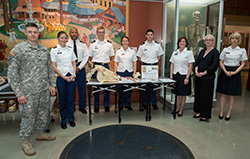
|
Caption:
Staff from the Department of Defense Veterinary Pathology Residency Program (DODVPR), Joint Pathology Center (JPC), gathers in front of one of their stations during the June Medical Museum Science Café titled "Veterinary Pathology - Disease Detectives Solving Mysteries with a Microscope." The monthly informal talk was held Tuesday, June 28, 2016, at the National Museum of Health and Medicine in Silver Spring, Maryland. (National Museum of Health and Medicine photo by Matthew Breitbart / Released) |
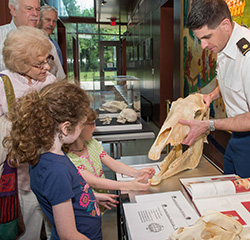
|
Caption:
Major Jason Crawford, of the Department of Defense Veterinary Pathology Residency Program (DODVPR), Joint Pathology Center (JPC), talks to young attendees about differences and similarities between skulls using comparative anatomy during the June Medical Museum Science Café titled "Veterinary Pathology - Disease Detectives Solving Mysteries with a Microscope." The monthly informal talk was held Tuesday, June 28, 2016, at the National Museum of Health and Medicine in Silver Spring, Maryland. (National Museum of Health and Medicine photo by Matthew Breitbart / Released) |
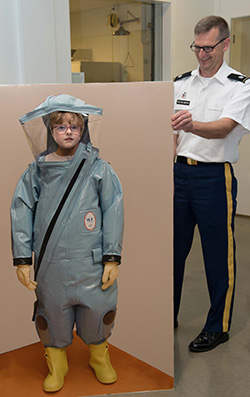
|
Caption:
A young visitor poses in the personal protective equipment (PPE) "selfie station" as Lt. Col. Norman Kreiselmeier of the Department of Defense Veterinary Pathology Residency Program (DODVPR), Joint Pathology Center (JPC) looks on at the June Medical Museum Science Café titled "Veterinary Pathology - Disease Detectives Solving Mysteries with a Microscope." Participants were able to gain an appreciation for the safety precautions taken by Army veterinary pathologists performing duties in biocontainment while working with highly infectious zoonotic diseases. The monthly informal talk was held Tuesday, June 28, 2016, at the National Museum of Health and Medicine in Silver Spring, Maryland. (National Museum of Health and Medicine photo by Matthew Breitbart / Released) |
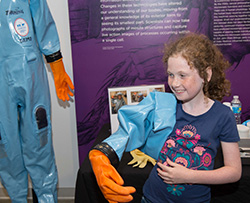
|
Caption:
A visitor tries on a glove from a Biosafety Level (BSL)-4 containment lab during a demonstration of personal protective equipment (PPE) at the June Medical Museum Science Café titled "Veterinary Pathology - Disease Detectives Solving Mysteries with a Microscope." The monthly informal talk was held Tuesday, June 28, 2016, at the National Museum of Health and Medicine in Silver Spring, Maryland. (National Museum of Health and Medicine photo by Matthew Breitbart / Released) |
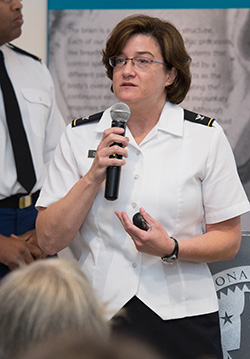
|
Caption:
Col. Jennifer Chapman of the Department of Defense Veterinary Pathology Residency Program (DODVPR), Joint Pathology Center (JPC) explains the U.S Army Veterinary Services mission and the roles of Army veterinarians and veterinary pathology residents using the "One Health" approach during the June Medical Museum Science Café titled "Veterinary Pathology - Disease Detectives Solving Mysteries with a Microscope." The monthly informal talk was held Tuesday, June 28, 2016, at the National Museum of Health and Medicine in Silver Spring, Maryland. (National Museum of Health and Medicine photo by Matthew Breitbart / Released) |
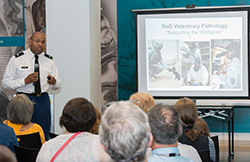
|
Caption:
Lt. Col. Tony Alves of the Department of Defense Veterinary Pathology Residency Program (DODVPR), Joint Pathology Center (JPC) highlights the contributions of Army veterinary pathologists to military medical research, military working and government owned animals, and privately owned animals of DoD service members and retirees during the June Medical Museum Science Café titled "Veterinary Pathology - Disease Detectives Solving Mysteries with a Microscope." The monthly informal talk was held Tuesday, June 28, 2016, at the National Museum of Health and Medicine in Silver Spring, Maryland. (National Museum of Health and Medicine photo by Matthew Breitbart / Released) |
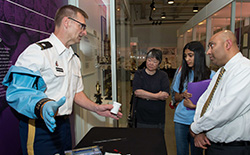
|
Caption:
Lt. Col Norman Kreiselmeier, of the Department of Defense Veterinary Pathology Residency Program (DODVPR), Joint Pathology Center (JPC) talks to attendees about safety precautions and the challenges in performing animal autopsies in Biosafety Level (BSL)-4 containment facilities during the June Medical Museum Science Café titled "Veterinary Pathology - Disease Detectives Solving Mysteries with a Microscope." The monthly informal talk was held Tuesday, June 28, 2016, at the National Museum of Health and Medicine in Silver Spring, Maryland. (National Museum of Health and Medicine photo by Matthew Breitbart / Released) |
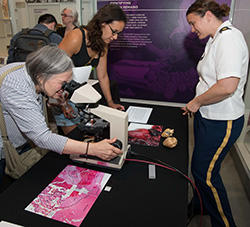
|
Caption:
Major Erin Ball, of the Department of Defense Veterinary Pathology Residency Program (DODVPR), Joint Pathology Center (JPC) assists participants in viewing a "mystery" slide using histological preparations during the June Medical Museum Science Café titled "Veterinary Pathology - Disease Detectives Solving Mysteries with a Microscope." The monthly informal talk was held Tuesday, June 28, 2016, at the National Museum of Health and Medicine in Silver Spring, Maryland. (National Museum of Health and Medicine photo by Matthew Breitbart / Released) |
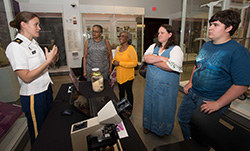
|
Caption:
Major Erica Barkei, of the Department of Defense Veterinary Pathology Residency Program (DODVPR), Joint Pathology Center (JPC), talks to participants about histologic similarities and differences in various tissues between animal species during the June Medical Museum Science Café titled "Veterinary Pathology - Disease Detectives Solving Mysteries with a Microscope." The monthly informal talk was held Tuesday, June 28, 2016, at the National Museum of Health and Medicine in Silver Spring, Maryland. (National Museum of Health and Medicine photo by Matthew Breitbart / Released) |
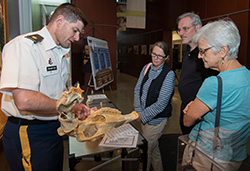
|
Caption:
Major Jason Crawford, of the Department of Defense Veterinary Pathology Residency Program (DODVPR), Joint Pathology Center (JPC) talks to attendees about differences and similarities between skulls using comparative anatomy during the June Medical Museum Science Café titled "Veterinary Pathology - Disease Detectives Solving Mysteries with a Microscope." The monthly informal talk was held Tuesday, June 28, 2016, at the National Museum of Health and Medicine in Silver Spring, Maryland. (National Museum of Health and Medicine photo by Matthew Breitbart / Released) |



